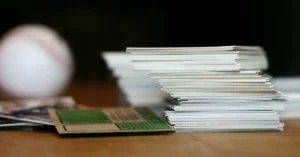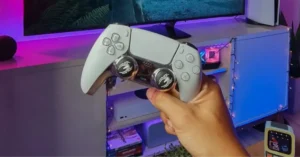Explore clever ways to pump up your basketball without using a pump through my professional advice. From homemade solutions to creative tricks, discover how to get your basketball inflated without a pump and keep your game going.
How to Inflate a Basketball Without a Pump? The Basics
When you’re eager to hit the court, understanding how to inflate your basketball correctly is key to a good game. The correct air pressure is crucial; it affects the ball’s bounce and firmness. An inflated basketball should be firm to the touch and bounce appropriately when dropped from chest height.
Optimal Performance
A standard basketball typically requires a pressure range of 7 to 9 pounds per square inch (PSI) for optimal performance. This recommended pressure ensures that the ball won’t be too soft or overly firm.
Checking Pressure
You can check if your basketball has enough air by pressing your palms against it. The ball should give a little but not too much. Also, a well-inflated ball should bounce back up to your waist when dropped from chest level.
Inflation Materials
- Compressed Air: This is a handy alternative if a pump isn’t available. You’d use the can’s thin tube to insert air into the valve.
- Straw: A straw can function as a makeshift inflation tool in a pinch. You’ll insert one end into the valve and blow into the other, carefully monitoring pressure.
Remember: Over or under-inflation can both alter the ball’s intended performance. Always aim to maintain the recommended pressure for your basketball to ensure the best playability on the court.
Materials for Inflation Without a Pump

When you find yourself needing to inflate a basketball but without the standard pump and needle on hand, you still have options! The following materials can help you get your basketball game-ready in no time:
- Straw: A flexible straw is one of the simplest makeshift tools you can use. Insert one end into the basketball’s valve and blow air through the other end. Remember to do so in short bursts to avoid over-inflation.
- Balloon: Use a balloon to transfer air into the basketball. Inflate the balloon, pinch the neck to prevent air from escaping, and align the opening with the ball’s air valve to channel the air inside.
- Inflation Needle: If you have an inflation needle but no pump, you can still use it in conjunction with a straw or pen tube to blow air into the ball.
- Adapter: A bike pump adapter can come in handy, as it allows a standard bike pump to interface with a basketball valve.
- Tubeless Valve Stem: For a more hands-off approach, use a tubeless valve stem with a CO2 cartridge to quickly inflate the basketball.
Here’s a quick reference table to ensure you have everything you need:
| Material | Use Case |
|---|---|
| Straw | Blow air directly into the valve. |
| Balloon | Transfer air from the balloon to the ball. |
| Inflation Needle | Use with a straw/pen tube if you lack a pump. |
| Adapter | Connect a bike pump to the basketball valve. |
| Tubeless Valve Stem | Use with a CO2 cartridge for fast inflation. |
Remember to always insert these tools gently into the ball’s valve to preserve its integrity and prevent damage. With these items, you’ll be able to inflate your basketball and hit the court in no time!
Alternative Inflation Techniques

If you’re caught without a traditional pump, don’t fret—your basketball can still hit the court with full bounce. Below are some creative, yet practical, ways to get air into your ball without standard equipment.
Using a Straw and a Balloon
If you need to inflate your basketball without a needle, a balloon can serve as a makeshift inflation device. First, blow up the balloon as large as possible and pinch the neck to prevent air from escaping. Next, insert the end of a straw into the basketball’s valve and the other end into the balloon’s neck. Release your pinch, and the balloon’s air will help inflate the ball.
Applying Manual Pressure
For a more hands-on approach, you can manually pump air into your ball. Begin by opening the ball’s valve with a paperclip or a similar tool. Then, press down on the valve and hold the ball tightly against your body. By taking deep breaths and blowing into the valve, you can gradually inflate a deflated ball. It might take longer, but it’s a useful method when resources are limited.
Utilizing Compressed Air
Lastly, a can of compressed air—typically used for cleaning keyboards—can come to the rescue. Attach the compressor nozzle securely to the basketball’s air valve. Then, gently squeeze the trigger to release short bursts of air, effectively using this method to inflate your basketball. This technique is also mentioned in helpful guides like How to Inflate a Basketball even without a pump or needle.
Finding Air Pressure and Avoiding Damage

Properly inflating your basketball is crucial for optimal performance and longevity. It’s vital to find the right air pressure without causing damage to your ball. Use a pressure gauge to check for precise pressure levels, and avoid overinflation or underinflation to maintain your ball’s condition.
Checking the Ball’s Air Pressure
To measure the air pressure, align the air pressure gauge onto your basketball’s valve. The ideal pressure for a standard basketball is 7.5 to 8.5 psi (pounds per square inch). Ensure that the gauge is pressed firmly to prevent air from escaping while you check the pressure.
Preventing Overinflation or Underinflation
An overinflated ball can bounce erratically and may suffer from reduced grip, while an underinflated ball may not bounce correctly and can cause premature wear. To evade these issues:
- Overinflation: Stop adding air once the pressure reaches the upper recommended limit (8.5 psi). This helps prevent stress on the seams and reduces the risk of the ball warping or bursting.
- Underinflation: If the ball feels flat, add air in small increments and frequently check the pressure to make sure it’s within the safe range. Avoid using the ball if it’s noticeably underinflated to prevent damage to the structure.
By closely monitoring air pressure and being gentle during the inflation process, you ensure a durable and playable basketball.
Care and Storage After Inflation

After you’ve successfully inflated your basketball, it’s important to ensure proper care and storage to maintain its performance and longevity. Here are some friendly tips to help you keep your basketball game-ready:
Location is Key:
- Indoors: Store your basketball indoors, away from extreme temperatures, which can affect the ball’s firmness and bounce.
- Cool & Dry: Choose a cool, dry place to avoid moisture buildup that can damage the material of the basketball.
Maintain Firmness:
- Check the ball regularly to ensure it is properly inflated. A well-inflated basketball will have the best bounce and perform optimally during your game.
- Use a pressure gauge to confirm the PSI levels if one is available to you. The ideal range is usually around 7.5 to 8.5 PSI.
Avoid Compression:
- Don’t stack heavy objects on top of your basketball. This could deform the ball and affect your game.
- Keep it out of cramped spaces where it might get squished.
Prepare for Next Use:
- Before storing, wipe down the basketball with a clean cloth to remove any dirt or debris.
- Occasionally, rotate the position of the ball to prevent it from resting on the same spot, which helps in retaining its shape.
Regular Checks:
- Periodically take out your basketball and give it a bounce to assess its condition.
- Look for signs of wear or damage, and address them promptly to prevent further deterioration.
By following these tips, you can ensure that your basketball is always ready for the next game, providing consistent performance and reliable bounce when you hit the court.
FAQ
How do you inflate a basketball at home?
Use a basketball pump with a needle attachment. Insert the needle into the air valve of the basketball and pump air until it reaches the desired pressure. Most basketball pumps can be operated manually or with an electric pump.
Do you need a pump for a basketball?
Yes, a pump is essential for inflating a basketball. The pump allows you to inject air into the ball through the air valve, ensuring proper inflation and optimal performance during play.
Can you inflate a basketball with heat?
No, inflating a basketball with heat is not recommended and can damage the ball. The proper method for inflating a basketball is to use a pump to inject air into the ball through the air valve. Heating the ball can cause the material to expand unevenly or even melt, leading to irreversible damage.
If you enjoyed reading about the topic: How to Inflate a Basketball Without a Pump, leave a comment and stay updated on Pinterest for more exciting basketball news.
Leave me a comment and make sure to also check out NBA Consistency Sheet.






